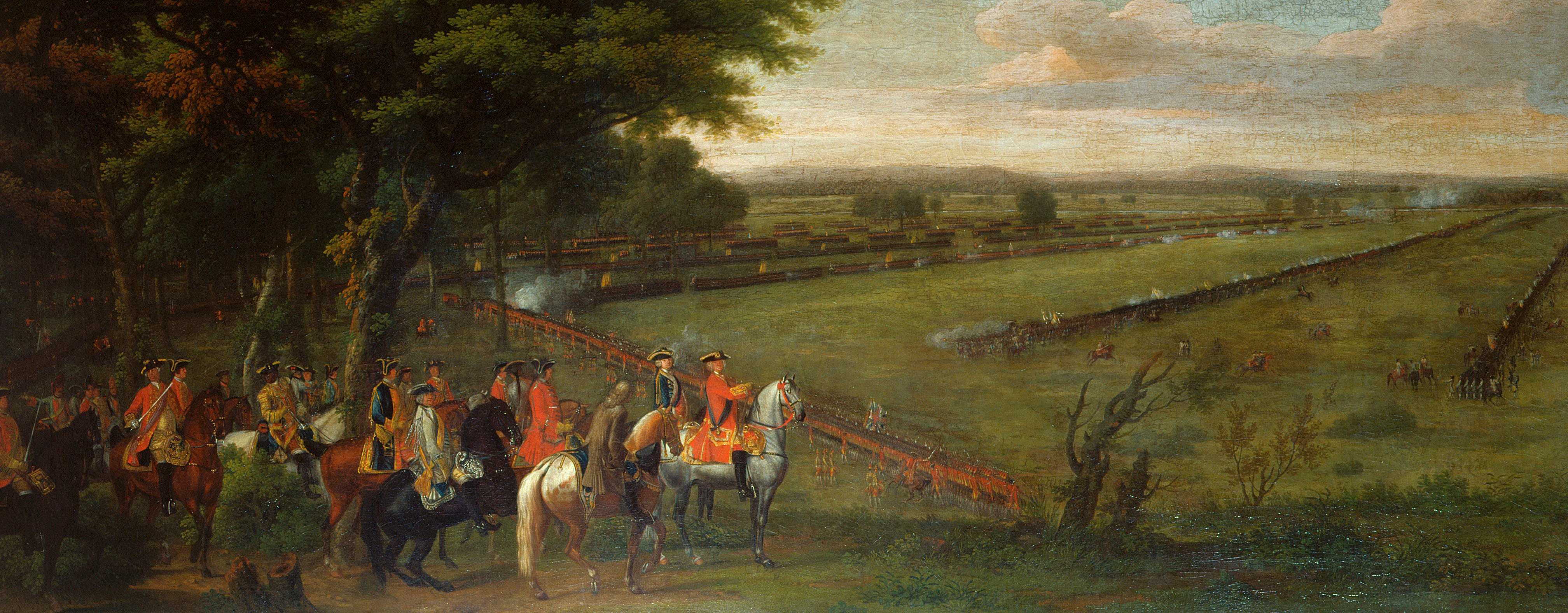
War of the Austrian Succession (1740-8)
Includes much of the mapping collected by William Augustus, Duke of Cumberland, as Captain General of the British army
Order of battle of the Allied army at Estaimbourg and Chateau de Bié, 1744 (Estaimbourg, Walloon Region, Belgium) 50°40'47"N 03°18'28"E; (near Pecq, Walloon Region, Belgium) 50°41'10"N 03°20'16"E
1744 or laterPencil, pen, ink and watercolour on paper; some pricking through | 41.8 x 54.1 cm (image and neatline) | RCIN 729032
The tentative attribution to Humphrey Bland is made solely on the basis of the inscription on the verso. Bland served with the Allied army in Flanders at the time of the encampment at Estaimbourg and, indeed, is named as one of the Brigadiers commanding a cavalry brigade of the First Line on this order of battle. He was to be promoted Major-General on 30 March 1745, having seen battle at Dettingen (27 June 1743) and at Culloden (16 April 1746), becoming Commander-in-Chief in Scotland on 17 September 1747. He went on to become a Lieutenant-General. He had been made Quarter-Master General to the British Forces in 1742, a post he held until his death in 1763. He was a friend of the Duke of Cumberland and the author of A Treatise of Military Discipline first published in 1727, and republished in many editions.
The ‘Prince of Wales’ referred to in the note on the verso of this order of battle was Frederick, Prince of Wales, eldest son of George II, father of George III, and elder brother to William Augustus Duke of Cumberland. If this order of battle came directly to the Prince of Wales, who was not on good terms with his brother the Duke of Cumberland, it is possible that the document passed directly to George III from his father, rather than from his uncle's collection.
The details and names of commanders and regiments are almost the same as for RCIN 729031 which refers to the encampment of the Allied army at the Chateau de Bié near Estaimbourg, shown on RCIN 729029. There are a few omissions of names, and some alterations in the position of others, and variations in spelling. Regiments are coloured according to nationality: British (red), Hanoverian (yellow), Austrian (green), Dutch (blue).
The General Officers of the First Line are Generals Maurice de Nassau Commandant en Chef de Troupes Hollandois, Ginkel, De Wendt, Honywood; Lieutenant-Generals Couriere, Philipsdaal, V. denduin, La Rocque, Smitzart, Chanclos, Sommerfeldt, Ligonier, Campbell; Major-Generals Schaak, Hompesch, Brakel, Constant, Rumps, Lanoi, Ariosti, Midaeten, Soubiron, Campbell, Pulteney, Wentworth, Launay, Montignie, Albermarle; Brigadiers-General M. Heust, Scaege, Vryberghe, Salis, Halker, G.V. Effelsu, Burmania, V. Leyde, Skelton, Churchill, Crawford, Bland.
The General Officers of the Second Line are General Baron de Cronstrom; Lieutenant-Generals Coenders, Swartsenberg, Aylva, Geisrugg, D'Ilten, Hawley; Major-Generals Pfiosky, Sandouville, Matha, Lieuwe, Villatte, M:c Hugo, Geminghen, Zastrow, Howard, Onslow, St. Clair, Hammerstein, Grote, Rothes; Brigadiers-General Heurst, Slipenbach, Everstein, Sturler, Elias, Rode V. Steekeren, Boselager, Ingoldsby.
A detachment of Scotch Highlanders is shown to the right between the First and Second Lines. The reserve corps are commanded by Lieutenant-General Beresnay and Major General Forgatsch.
Additional text: [bottom left, a summary of the numbers of British, Hanoverian, Dutch and Austrian squadrons and battalions of the First and Second Lines; bottom right, a summary of the numbers of British, Hanoverian Dutch and Austrian 6- and 3-pounder cannons, pontoons and howitzers.]
For further reading, see:
J.A. Houlding, ‘Bland, Humphrey (1685/6–1763)’, Oxford Dictionary of National Biography, 2004; online edn, Jan 2008.
Condition: six fold lines; formerly folded to 10.3 x 10.3 cm; some foxing; torn at top of central vertical fold; some surface dirt to both sides. Verso: brown discolouration; induced discolouration.
? Humphrey Bland (1686?-1763) (draughtsman)
Subject(s)
Army-GBArmy-HanoverArmy-AustriaArmy-DutchArmy-Allied army (War of the Austrian Succession, 1740-48)Watermark: Fleur-de-lys in shield, crown above; countermark: IV
Mark, stamped: 377
Condition: six fold lines; formerly folded to 10.3 x 10.3 cm; some foxing; torn at top of central vertical fold; some surface dirt to both sides. Verso: brown discolouration; induced discolouration
41.8 x 54.1 cm (image and neatline)
42.1 x 54.4 cm (sheet)
Manuscript title:
Ordre de Battaille de L'Armee Alliée en Flandres. Aoust. Anno. 1744. / [under the command of] Marechaux S:A: Le Duc D'Arrenberg [and] S.Exc:ce Le Feldt Marechal Wade.
Additional text:
[bottom left, a summary of the numbers of British, Hanoverian, Dutch and Austrian squadrons and battalions of the First and Second Lines; bottom right, a summary of the numbers of British, Hanoverian Dutch and Austrian 6- and 3-pounder cannons, pontoons and howitzers.]
Annotations:
George III heading: Order of Battle August 1744.
Other annotations: (Recto) none. (Verso) [left of centre, ink, to fit inside the original outer folded panel:] To His Royal Highness The / Prince of Wales. / By His most Obedient and / most Dutifull humble Servant / [signature:] Hum: Bland; [right, red pencil:] 8/45 [and, black pencil:] X/10; [top left, black pencil, erased:] X/1[?]; [top right, black pencil, erased:] Order of Battle.
George III catalogue entry:
Order of Battle Ordre de Bataille de l'Armée Alliée en Flandre sous les Marechaux d'Arenberg et Wade en Aoust 1744. MS.
Subject(s)
Estaimbourg, Walloon Region, Belgium (50°40'47"N 03°18'28"E)
near Pecq, Walloon Region, Belgium (50°41'10"N 03°20'16"E)
Bibliographic reference(s)
J.A. Houlding, ‘Bland, Humphrey (1685/6–1763)’, Oxford Dictionary of National Biography, 2004; online edn, Jan 2008
Page revisions
3 November 2024
Current version






